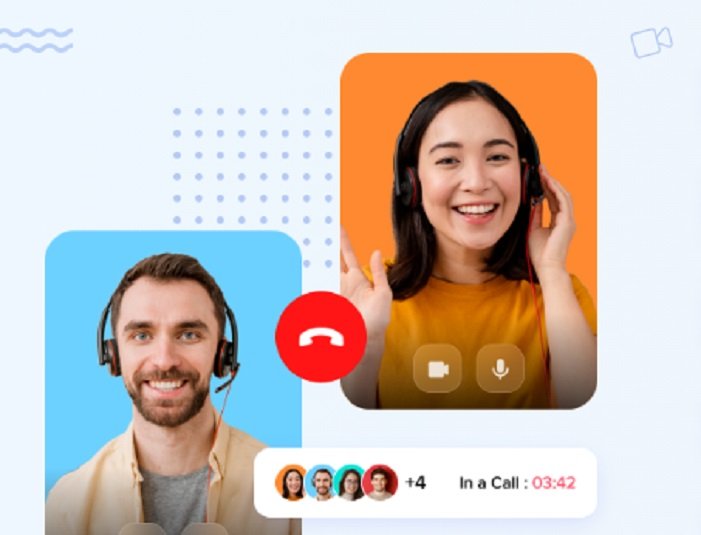The immediacy and personalization offered by video chat support boost customer satisfaction, helping businesses retain their competitive edge. Video chat can also reduce product returns and other costs associated with dissatisfied customers. A reliable video chat API can accommodate growth and adapt to changing circumstances, boosting business productivity. However, selecting the right API requires careful consideration of several key factors.
Scalability
While building a video chat solution from scratch is tempting, that approach requires substantial technical expertise and time. Finding a scalable video call API that integrates smoothly with your app and supports your business goals without compromising user experience is important.
A robust video chat SDK like Agora.io offers a centralized system to manage incoming calls and data. Using this, developers can ensure that their apps perform well under heavy load and scale to accommodate more users. This means reducing latency, improving call quality, and allowing the sharing of files in real time.
In addition, it’s also important to choose a video call API that can support multiple devices and platforms, such as desktops, mobile phones, tablets, and more. This flexibility makes adding a video call feature to your mobile app or website easy without rewriting the code.
Consumer interest in communicating with businesses via video is rising. In fact, according to a Vonage report, 14% of consumers use video chat with companies daily.
Video chat is convenient and personal and enhances customer satisfaction. Moreover, it helps to reduce customer service costs by increasing agent productivity and lowering resolution times. As a result, companies can save on overhead expenses and maximize profits. Lastly, video communication encourages remote work and telehealth, driving customer loyalty and increasing brand trust.
Flexibility
Video chat APIs provide developers with out-of-the-box functionality that eliminates the need for complicated engineering and saves time and money. They leverage secure WebRTC technology to enable audio and visual communication with site visitors, streamlining customer interactions and improving agent productivity.
Evaluate your business needs to determine your organization’s best video conferencing solution. For example, you might need a platform with enhanced agent controls to ensure customers are not interrupted during video conversations by external distractions or unwanted appearances in the background. Similarly, you may require the ability to control customers’ cameras or microphones to create a sense of privacy and comfort.
Another important feature is whether the video chat API offers customization and seamless integration. Some providers provide customizable chat widgets to align with website aesthetics and captivate users’ attention. Others enable businesses to build their custom chat apps with the help of a self-hosted video SDK and API. This gives companies full control over their chat application’s features, deployment and security.
Regardless of your chosen platform, look for a provider that offers multiple flexible options and a quick implementation process. Some video chat APIs and SDKs allow you to customize your app with 1-to-1 video conferencing, file sharing, online presence indicators, and more.
Integration
Embedding video chat in your app or website gives users an instant, seamless way to connect with your business. They don’t have to navigate through a separate third-party app or find your contact page to get help. Video chat enables enterprises to deliver a high-quality customer experience (CX) that exceeds expectations and meets modern customer needs.
A robust video call API allows developers to build various use cases, including one-to-one direct calls, group chats, screen sharing and content recording. It also offers a variety of features to improve the user experience, such as noise cancellation, muting, and moderation. In addition, it provides high reliability and flexibility for varying network conditions, with support for adaptive bitrate control that optimizes audio and video streaming for changing bandwidth.
A good video chat API has a rich library of developer resources that expedite development. This includes documentation, tutorials and responsive 1:1 customer support to answer any questions and address any concerns. This way, developers can focus on building the feature set their business needs, not worrying about integration and maintenance. They can also rely on their video chat API provider to handle any problems with data streaming and connectivity. This frees up essential resources and ensures the business can deliver a quality user experience that exceeds expectations.
Security
An API (application programming interface) is an intermediary that enables different software applications to communicate seamlessly. Providing out-of-the-box functionality, video chat APIs save engineers the time and effort of building communication features from scratch.
Video calling APIs use secure protocols like WebRTC to enable peer-to-peer real-time internet communication without requiring additional plugins or downloads. Moreover, video chat APIs provide quality control tools for developers to customize apps with features like virtual video backgrounds and custom layouts. Video conferencing API pricing is based on the quality of the video you wish to feature in your app, the number of users, and the duration you plan to utilize it.
Integrated with CRM and contact center software, video chats allow agents to access comprehensive customer information during interactions. This enhances immediacy and personalization, a key aspect of superior CX. It also enables agent training to be focused on specific scenarios that are most common in your business, further improving issue resolution and overall service quality.
In addition, a good video chat API will offer robust encryption protocols to protect customer data during transmission, preventing interception and safeguarding digital sovereignty. It should also have a reliable track record of performance, with minimal downtime and a failsafe mechanism for handling unexpected issues. It should also support a variety of UI options to suit any application.

